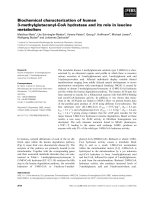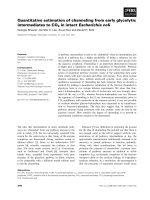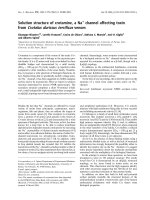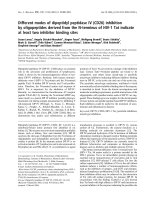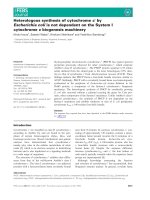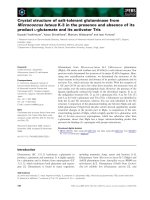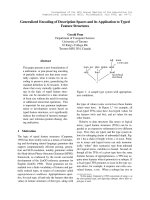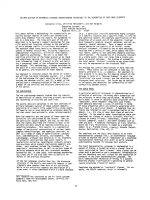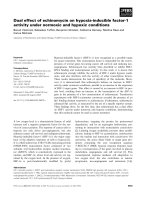Báo cáo khoa học: "Growth response of holm oak (Quercus ilex L) to commercial thinning in the Montseny mountains" doc
Bạn đang xem bản rút gọn của tài liệu. Xem và tải ngay bản đầy đủ của tài liệu tại đây (603.41 KB, 10 trang )
Original
article
Growth
response
of
holm
oak
(Quercus
ilex
L)
to
commercial
thinning
in
the
Montseny
mountains
(NE
Spain)
X
Mayor
F Rodà
Centre
de
Recerca
Ecològica
i Aplicaciones
Forestals
(CREAF),
Universitat Autònoma
de
Barcelona,
08193
Bellaterra,
Spain
(Received
17
August
1992;
accepted
6
January
1993)
Summary —
Growth
responses
of
holm
oak
(Quercus
ilex)
to
commercial
thinning
were
studied
in
the
Montseny
Biosphere
Reserve
(northeast
Spain),
where
selection
thinning
for
firewood
production
is
currently
the
dominant
form
of
management
in
holm
oak
forests.
Thinning
significantly
increased
mean
stem
diameter
increment
by
83%
over
that
of
unthinned
plots
during
the
6-9-yr
period
after
thinning,
and
by
48%
from
9-12
yr
after
thinning.
Absolute
diameter
increment
was
positively
corre-
lated
with
initial
diameter
at
1.30
m
from
the
ground
(dbh)
both
in
thinned
and
unthinned
plots.
Thin-
ning
increased
growth
in
large
trees
more
than
in
smaller
trees.
Relative
diameter
growth
was
nega-
tively
correlated
with
initial
dbh.
It
is
concluded
that individual
holm
oak
stems
in
previously
coppiced
stands
respond
vigourously
to
thinning,
and
still
do
so
6-9
yr
after
thinning.
The
growth
response
di-
minishes
9-12
yr
after
thinning
due
to
canopy
closure.
However,
absolute
rates
of
stand
growth,
as
well
as
basal
area
and
stem
biomass
increments,
were
unaffected
by
thinning
during
these
time
in-
tervals,
an
example
of
density
compensation.
canopy
closure
I
Quercus
ilex
= holm
oak
I
selection
thinning
I
stand
growth
/
tree
growth
Résumé —
Effet
d’une
éclaircie
commerciale
sur
la
croissance
d’un
chêne
vert
(Quercus
ilex
L)
dans
les
montagnes
du
Montseny
(NE
de
l’Espagne).
L’effet
d’une
éclaircie
commerciale
sur
la
croissance
du
chêne
vert
(Quercus
ilex)
a
été
étudié
dans
la
réserve
de
la
Biosphère
du
Montse-
ny
(NE
Espagne).
Dans
cette
région,
l’éclaircie
sélective
pour
la
production
du
bois
de
chauffage
est
la
forme
la
plus
commune
de
gestion
des
forêts.
L’éclaircie
a
augmenté
l’accroissement
de
diamètre
des
tiges
de
83%
par
rapport
aux
placettes
non
éclaircies
entre
6
et
9
ans
et
de
48%
entre
9
et
12
ans
après
le
traitement.
L’accroissement
absolu
de
diamètre
est
corrélé
positivement
avec
le
dia-
mètre
initial
à
1,30
m.
Les
gros
arbres
ont
davantage
augmenté
leur
croissance
que
les
petits.
L’ac-
croissement
relatif
en
diamètre
est
corrélé
négativement
avec
le
diamètre
initial
à
1,30
m.
On
peut
conclure
que
les
tiges
du chêne
vert
dans
le
taillis
étudié
ont
une
réponse
vigoureuse
à
l’éclaircie
et
que
cette
réponse
se
prolonge
encore
6
à
9
ans
après.
L’effet
sur
la
croissance
diminue
9
à
12
ans
après
l’éclaircie
par
suite
de
la
fermeture
du
couvert
végétal.
Cependant,
les
taux
absolus
d’accrois-
sement
du
peuplement,
ainsi
que
la
croissance
de
la
surface
terrière
et
de
la
biomasse
des
tiges,
ne
sont
pas
affectés
par
l’éclaircie
pendant
ces
intervalles
de
temps,
ce
qui
constitue
un
exemple
de
compensation
de
la
densité.
fermeture
de
la
couverture
végétale
/
Quercus
ilex
=
chêne
vert
/
éclaircie
sélective
/
accroissement
du
peuplement /
croissance
des
tiges
INTRODUCTION
Selection
thinning
is
a
standard
silvicul-
tural
practice
that
has
been
successful
in
many
forest
types
for
sustained
timber
pro-
duction
in
uneven-aged
stands
(Boudru,
1989).
Additionally,
thinning
can
be used
to
favour
tree
regeneration,
improve
the
environmental
conditions
for
wildlife,
modi-
fy
the
likelihood
and
impact
of
disturban-
ces,
or
create
spatial
patterns
of
communi-
ty
types
and
species
richness
(Johnson
and
Krinard,
1983;
Frankling
and
Forman,
1987).
Thinning
increases
the
availability
of
light,
water
and
nutrients
to
the
remaining
trees.
As
a
result,
tree
growth
is
usually
in-
creased
after
thinning.
Growth
responses
to
thinning
have
been
modeled
to
provide
increased
knowledge
to
be
applied
in
fo-
restry
(Hibbs
and
Bentley,
1984;
Piennar
and
Shiver,
1984;
Whyte
and
Wollons,
1990).
Thinning
effects
on
tree
growth
are
usually
studied
in
terms
of
stem
diameter
increment,
height
growth,
and
canopy
ex-
pansion
of
the
remaining
trees
(Hamilton,
1981;
Ducrey,
1988;
Baldwin
et
al,
1989;
Bouchon
et
al,
1989;
Cutter
et
al,
1991),
but
effects
on
production
of
stump
re-
sprouts
(Ducrey
and
Boisserie,
1992;
Re-
tana
et
al,
1992)
and
epicormic
sprouts
(Paysen
et al,
1991)
have
been
studied
as
well.
Growth
responses
to
thinning
are
rel-
atively
well
known
in
many
coniferous
(Hamilton,
1981;
Baldwin
et
al,
1989;
Whyte
and
Woollons,
1990)
and
decidu-
ous
broad-leaved
species
(Bouchon
et
al,
1989;
Cutter
et al,
1991).
A
peculiar
situation
arises
in
extensive
tracts
of
Mediterranean
hardwood
forests
that
were
intensively
coppiced
in
the
past
for
charcoal
production,
resulting
in
high
density
even-aged
stands
of
relatively
small
stump
resprouts.
After
abandonment
of
charcoal
production
in
the
1950s,
many
private
owners
shifted
in
the
early
1970s
to
selection
thinning
for
firewood,
a
silvicul-
tural
method
that
was
previously
practised
only
to
a
limited
extent.
This
important
management
change
is
widespread
in
holm
oak
forests
in
the
region
of
relatively
high
rainfall
in
northeast
Spain.
Usually
about
one-third
to
one-half
of
the
canopy
trees
are
cut
at
intervals
from
18-25
yr,
changing
the
stand
to
an
uneven-aged
stand.
There
is
very
little
quantitative
infor-
mation
on
the
effects
of
such
change,
ei-
ther
on
tree
growth
and
forest
production
or
on
its
ecological
consequences.
The
purpose
of
this
paper
is
to
report
re-
sults
on
tree
and
stand
growth
after
a
com-
mercial
thinning
of
a
holm
oak
stand,
in
the
6-12-yr
interval
after
thinning.
MATERIAL
AND
METHODS
Study
site
This
study
was
carried
out
within
the
Torrent
de
la
Mina
catchment
at
La
Castanya
Biological
Station
(41
° 46’
N,
2°
21’
E)
in
the
Montseny
mountains,
a
natural
park
and
biosphere
re-
serve
in
northeast
Spain.
The
lower
half
of
this
200-ha
catchment
is
covered
by
a
dense
holm
oak
forest
where
biomass,
primary
production
and
nutrient
cycling
have
been
extensively
in-
vestigated
(Ferrés
et
al,
1984;
Escarré
et
al,
1987;
Avila
and
Rodà,
1988;
Caritat
and
Terra-
das,
1990;
Mayor,
1990;
Rodà
et al,
1990;
Can-
adell
and
Rodà,
1991;
Bonilla
and
Rodà,
1992;
Mayor
and
Rodà,
1992).
Climate
is
subhumid
Mediterranean
with
a
mean
annual
precipitation
of
870
mm.
The
bedrock
is
a
metamorphic
phyl-
lite
and
soils
are
rather
shallow,
sandy-loam
dystric
xerochrepts
with
a
high
stone
content.
Slopes
are
very
steep
(mean
34°).
Holm
oak
is
virtually
the
only
tree
species
in
the
tree
layer.
The
understory
is
sparse.
Most
of
this
forest
has
not
been
disturbed
since
the
end
of
charcoal
production
in
the
1950s.
The
present
stand
structure
is
dominated
by
multi-stemmed
trees
originating
from
stump
resprouting,
though
sin-
gle-stemmed
trees
are
also
common.
Field
measurements
For
this
study
we
took
advantage
of
a
commer-
cial
thinning
carried
out
in
1979
by
the
private
owner
of
a
sector
of
the
east-facing
slope
of
the
catchment,
at
an
altitude
of
900
m.
Estimated
mean
annual
temperature
at
this
topographic
position
is
11-12°C.
In
late
June
1985,
4 repli-
cate
plots
were
laid
out
within
the
thinned
area,
and
3
control
plots
in
an
adjacent
unthinned
area.
Since
the
thinning
was
commercial
instead
of
experimental,
thinned
and
unthinned
plots
could
not
be
interspersed.
However,
the
thinned
and
unthinned
plots
were
very
close
together,
had
the
same
slope
aspect
and
steepness
and
similar
soil.
Aerial
photographs
taken
in
1978
before
thinning
confirmed
that
the
forest
was
quite
homogeneous.
Circular
plots
with
an
area
of
154
m2
were
used.
When
the
plots
were
laid
out,
dbh
(diame-
ter at
1.30
m
from
the
ground)
was
measured
for
all
living
stems
forming
the
tree
layer
(dbh
≥
5
cm).
All
stems
were
permanently
numbered
and
a
line
was
painted
on
the
exact
point
along
the
stem
where
diameter
was
measured.
This
greatly
increased
the
accuracy
of
stem
diameter
increments
determined
from
repeated
measure-
ments.
Stem
diameters
were
remeasured
in
July
1988
and
July
1991.
Diameter
increment
(over
bark)
for
each
stem
during
each
period
of
3
or
6
yr
(1985-1988,
1988-1991,
and
1985-1991)
was
determined
from
difference
in
diameter
at
both
dates.
Stem
biomass
(wood
plus
bark
of
the
trunk
and
branches
down
to
5
cm
in
diame-
ter)
for
each
stem
was
estimated
for
each
date
through
an
allometric
regression
on
dbh
derived
for
this
holm
oak
forest.
From
the
several
availa-
ble
regressions
(Canadell
et
al,
1988),
that
for
trees
4-7
m
in
height
was
used,
since
height
of
most
stems
was
within
this
range.
The
regres-
sion
was:
where
SB
is
stem
biomass
(kg
dry
weight),
and
dbh
is
in
cm.
We
preferred
to
estimate
stem
bio-
mass
instead
of
total
aboveground
biomass
be-
cause,
as
here
defined,
it
is
the
component
of
the
tree
utilized
for
firewood,
and
because
total
biomass
includes
the
biomass
of
fine
branches
and
leaves.
The
latter
components
are
rather
dynamic
and
their
allometric
relationships
with
dbh
are
likely
to
change
as
a
result
of
thinning.
Conversely,
for
stem
biomass
the
slow
rates
of
growth
displayed
by
holm
oak
makes
unlikely
that
allometric
relations
with
dbh
change
to
any
significant
extent
during
the
first
12
yr
after
thin-
ning.
Stem
biomass
increment
was
determined
as
the
difference
between
biomass
at
initial
and
final
dates
for
the
periods
1985-1988,
1988-
1991
and
1985-1991.
Statistical
analysis
Effects
of
thinning
on
stem
diameter
growth
rates
over
the
whole
study
period
were
tested
by
a
t-test,
using
the
arithmetic
mean
diameter
growth
rate
of
each
plot,
and
by
an
analysis
of
covariance
(ANCOVA)
of
individual
growth
rates
using
initial
stem
diameter
(dbh)
as
a
covariate.
Time-dependence
of
tree
and
stand
growth
rates
were
tested
by
repeated
measures
analy-
sis
of
variance.
To
guard
against
the
effect
of
autocorrelation
in
the
dependent
variable(s),
Greenhouse-Geisser
and
Hunyh-Feldt
epsilon
estimates
were
used
to
correct
the
P-values.
In
no case
did
these
corrections
affect
the
result
of
the
analyses
and
are
not
reported
here.
Analy-
ses
were
performed
with
the
SuperANOVA
sta-
tistical
package
(Abacus
Concepts,
1989).
During
the
study
period,
9
out
of
230
tallied
holm
oak
stems
developed
cracks
or
bumps
at
the
point
of
diameter
measurement,
preventing
a
meaningful
reading
of
their
diameter
incre-
ments.
These
stems
were
not
taken
into
ac-
count
in
analyses
involving
stem
growth
rates.
When
considering
stand
growth
rates
(basal
area
and
biomass
increments),
diameter
of
these
9
stems
at
the
dates
of interest
were
esti-
mated
by
linear
regression
of
final
dbh
on
initial
dbh.
RESULTS
Stand
structure
At
the
start
of
the
study,
ie
6
yr
after
thin-
ning,
density
and
basal
area
of
the
tree
layer
were,
as
expected,
significantly
high-
er
in
unthinned
than
in
thinned
plots.
Mean
density
was
2
837
±
348
(SE)
stems·ha
-1
in
unthinned
plots,
and
1
608
±
77
(SE)
stems·ha
-1
in
thinned
plots
(t = 4.0, df = 5,
P
= 0.01).
Mean
basal
area
was
28.2
±
4.5
(SE)
m2
·ha
-1
in
unthinned
plots,
and
11.3
±
1.0
(SE)
m2
·ha
-1
in
thinned
plots
(t
=
3.8,
df
=
5,
P=
0.013).
Mortality
from
6-12
yr
after
thinning
was
very
low.
Summing
over
all
plots,
only
4
out
of
230
initial
stems
died
during
this
6-yr
period.
This
yielded
a
mean
annual
mortality
rate
of
0.3%.
Ingrowth
to
the
tree
layer
(dbh
≥
5
cm)
is
also
very
limited
in
unthinned
holm
oak
plots
in
this
area
(Mayor
and
Rodà,
unpublished
data)
because
virtually
all
stems
with
dbh
<
5
cm
are
suppressed
stems
having
no
or
negligible
diameter
growth.
Stump
sprouts
were
abundant
in
the
thinned
plots
but
none
of
these
had
reached
a
dbh
of
5
cm
even
12
yr
after
thinning.
Therefore,
as
mortality
and
in-
growth
were
negligible,
stem
density
of
the
tree
layer
measured
6
yr
after
thinning
should
be
nearly
the
same
as
that
just
af-
ter
thinning.
In
this
way
we
can
estimate
that
this
commercial
thinning
removed
43%
of
the
holm
oak
stems
having
a
dbh
>
5
cm.
This
thinning
intensity
is
common
for
thinnings
undertaken
by
private
owners
at
Montseny.
The
same
computation
cannot
be
applied
to
estimate
the
percentage
of
basal
area
removed,
since
basal
areas
must
have
changed
during
the
first
6
yr
af-
ter
thinning.
However,
it
must
be
noted
than
thinning
intensity
was
higher
in
terms
of
basal
area
removed
than
it
was
in
num-
ber
of
stems,
because
thinning
was
more
intense
in
the
larger
size
classes,
as
is
commonly
the
case
at
Montseny.
This
can
be
deduced
from
the
higher
quadratic
mean
diameter
still
detectable
6
yr
after
thinning
in
unthinned
plots
(11.2
cm)
than
in
thinned
plots
(9.7
cm).
As
a
result
of
the
size-selective
thinning,
stems
with
a
dbh
>
15
cm
accounted
for
15%
of
the
number
of
stems
in
the
unthinned
plots
but
only
3%
in
the
thinned
plots
(fig
1).
Tree
growth
Absolute
stem
diameter
increment
Mean
absolute
stem
diameter
increment
during
the
interval
from
6-12
yr
after
thin-
ning
was
0.83
mm·yr
-1
(±0.05
SE,
n
=
3)
for
unthinned
plots,
and
1.43
mm·yr
-1
(±0.04
SE,
n
=
4)
for
thinned
plots.
The
ef-
fect
of
thinning
was
highly
significant
(t
=
9.7, df = 5,
P=
0.0002).
The
time-dependence
of
the
above
ef-
fect
can
be
addressed
by
analyzing
separ-
ately
data
for
the
period
1985-1988
(6-
9 yr
after
thinning)
and
1988-1991
(9-12
yr
after
thinning),
as
shown
in
table
I.
A
re-
peated
measures
analysis
of
variance
was
used
to
evaluate
significance
of
differenc-
es
through
time
and
those
due
to
treat-
ment
(thinned
versus
unthinned).
Both
time
and
treatment
had
a
significant
effect
(P
=
0.002
in
both
cases).
No
interaction
between
treatment
and
time
was
found.
Stem
diameter
increments
were
higher
for
thinned
than
for
unthinned
plots,
and
were
higher
during
the
first
period
(1985-1988)
than
the
second
(1988-1991)
for
both
thinned
and
unthinned
plots
(table
I).
Thin-
ning
increased
mean
stem
diameter
incre-
ment
by
83%
over
that
of
unthinned
plots
during
the
period
6-9
yr
after
thinning,
and
by
48%
from
9-12
yr
after
thinning.
Absolute
increments
(mm·yr
-1
)
in
stem
diameter
of
individual
holm
oaks
during
the
interval
from
6-12
yr
after
thinning
were
weakly
but
positively
and
significantly
cor-
related with
initial
stem
diameter,
both
in
thinned
and
unthinned
plots
(P
=
0.0002,
r =
0.38
and
P
=
0.0001,
r
= 0.34,
respec-
tively).
Thus,
large
trees
showed
on
aver-
age
higher
absolute
growth
rates
than
smaller
ones.
Linear
regressions
between
stem
diameter
increment
(y,
mm·yr
-1
)
and
initial
dbh
(x,
in
cm)
were
for
trees
in
un-
thinned
plots:
and
for
trees
in
thinned
plots:
An
ANCOVA
was
run
to
test
whether
thinning
still
had
a
significant
effect
on
di-
ameter
growth
after
discounting
the
effect
of
initial
dbh,
and
whether
there
was
a
sig-
nificant
interaction
between
thinning
and
initial
dbh.
The
full
ANCOVA
model
includ-
ed
terms
for
treatment
(thinned
or
un-
thinned),
initial
dbh
as
covariate,
and
the
interaction
between
both.
This
full
model
gave
a
significant
effect
of
dbh
(F
1.213
=
28.0,
P
=
0.0001),
as
expected
from
the
above
regressions;
a
non-significant
effect
of
treatment
(F
1.213
=
0.98,
P
=
0.32),
and
a
doubtfully
significant
interaction
(F
1.213
=
2.5,
P
=
0.12).
The
ANCOVA
was
then
re-
peated
deleting
the
non-significant
treat-
ment
term,
with
the
result
that
not
only
the
initial
dbh
but
also
the
interaction
between
thinning
and
dbh
became
highly
significant
(F
1.214
= 53.8,
P
= 0.0001).
This
means
that
thinning
increased
absolute
diameter
growth
rates
more
in
larger
trees
than
in
smaller
ones:
mean
diameter
increments
where
138%
higher
in
thinned
than
in
un-
thinned
plots
for
trees
of
dbh
11-15
cm,
and
98%
higher
for
trees
of
dbh
5-8
cm.
Relative
stem
diameter
growth
Relative
growth
rates
in
stem
diameter
were
computed
for
individual
stems
divid-
ing
the
annualised
absolute
increment
(mm
yr-1
)
in
a
given
period
by
the
stem
diameter
at
the
start
of
the
period,
and
ex-
pressing
the
result
as
a
percentage.
Mean
relative
diameter
increments
during
the
in-
terval
from
6-12
yr
after
thinning
were
0.87%
yr-1
and
1.64%
yr-1
,
in
unthinned
and
thinned
plots,
respectively
(table
I).
As
opposed
to
absolute
diameter
increments,
relative
diameter
growth
rates
during
the
interval
from
6-12
yr
after
thinning
were
weakly
but
negatively
and
significantly
cor-
related
with
initial
stem
diameter
(P
=
0.025,
r
=
-0.20
for
unthinned
plots,
and
P
= 0.016,
r = -0.25
for
thinned
plots).
The
corresponding
linear
regressions
between
relative
diameter
growth
rates
over
this
6-
yr
period
(y,
%
yr-1
)
and
initial
dbh
(x,
cm)
were,
for
trees
in
unthinned
plots:
and
for
trees
in
thinned
plots:
The
ANCOVA
gave
significant
effects
of
both
thinning
(F
1.213
=
12.1,
P
=
0.0006)
and
initial
dbh
(F
1.213
=
10.7,
P =
= 0.001),
without
significant
interaction
between
them.
The
repeated
measures
analysis
of
variance
gave
significant
effects
for
treat-
ment
and
time
(P <
0.002
in
both
cases),
and
for
their
interaction
(P
= 0.026).
The
in-
teraction
arose
because
during
the
first
pe-
riod
(1985-1988)
relative
diameter
incre-
ment
was
much
higher
in
thinned
than
in
unthinned
plots
while
this
difference
de-
creased
in
the
second
period:
mean
rela-
tive
diameter
increment
was
108%
higher
in
thinned
than
in
unthinned
plots
during
6-9
yr
after
thinning,
but
only
47%
higher
during
9-12
yr
after
thinning
(table
I).
Stand
growth
Basal
area
increment
During
the
interval
from
6-12
yr
after
thin-
ning,
mean
basal
area
of
the
tree
layer
in-
creased
in
the
unthinned
plots
from
28.2
to
30.2
m2
·ha
-1
(table
II).
Mean
basal
area
in
the
unthinned
plots
increased
from
11.3-
13.4
m2
·ha
-1
.
Mean
annual
basal
area
in-
crement
was
0.33
and
0.35
m2
·ha
-1
·yr
-1
in
unthinned
and
thinned
plots,
respectively
(table
II).
As
before,
a
repeated
measures
analy-
sis
of
variance
was
used
with
absolute
and,
separately,
relative
basal
area
incre-
ments
as
dependent
variables.
The
latter
was
calculated
dividing
the
absolute
basal
area
increment
of
each
plot
by
the
basal
area
at
the
start
of
the
considered
period,
and
expressing
the
result
as
a
percentage
(table
III).
For
absolute
increments,
neither
thinning,
time,
nor
their
interaction
were
significant
(P>
0.29
in
all
cases).
For
rela-
tive
increments,
both
thinning
and
time
were
significant
(P
=
0.0006
and
P
=
0.02,
respectively),
while
the
interaction
between
them
was
marginally
significant
(P
=
0.056).
Relative
basal
area
increment
had
to
be
higher
in
thinned
plots,
as
we
found,
since
absolute
basal
area
growth
was
not
affected
by
thinning
whilst
initial
basal
area
was
much
reduced
by
it.
Stem
biomass
increment
During
the
interval
from
6-12
yr
after
thin-
ning,
mean
stem
biomass
in
unthinned
plots
increased
from
72.0-77.3
t·ha
-1
(table
II),
while
that
of
thinned
plots
in-
creased
from
28.5
to
34.0
t·ha
-1
.
Mean
in-
crements
in
stem
biomass
were
0.88
and
0.91
t·ha
-1
yr-1
for
unthinned
and
thinned
plots,
respectively.
It
should
be
noted
that
the
above
increments
slightly
underesti-
mate
stem
production
since
some
stem
mortality
occurred
during
this
period.
A
repeated
measures
analysis
of
vari-
ance
with
absolute
and,
separately,
rela-
tive
stem
biomass
increments
(the
latter
calculated
as
explained
for
the
relative
ba-
sal
area
increment)
as
dependent
vari-
ables
yielded
the
same
results
as
de-
scribed
for
basal
area
growth.
This
is
no
surprise
since basal
area
is
a
function
of
squared
dbhs,
and
stem
biomass
is
an
al-
lometric
function
of
dbh
raised
to
an
expo-
nent
of
2.04
(see
Methods).
DISCUSSION
In
18
plots
of
closed
holm
oak
forest
span-
ning
most
of
the
topographic
variation
with-
in
the
Torrent
de
la
Mina
catchment,
the
mean
diameter
increment
during
1985-
1988
was
0.87
mm·yr
-1
(Mayor,
1990).
Our
results
for
the
unthinned
plots
are
very
similar:
1.06
mm·yr
-1
for
the
same
period,
and
0.83
mm·yr
-1
for
the
whole
6-yr
per-
iod.
Similar
growth
rates
(1.05
mm·yr
-1
)
were
found
in
a
lowland,
unthinned
holm
oak
coppice
on
calcareous
bedrock
in
southern
France
(Ducrey
and
Toth,
1992),
where
mean
precipitation
is
slightly
higher
than
at
Montseny
(1
000
mm·yr
-1).
In
con-
trast,
holm
oak
diameter
increments
were
much
smaller
(0.27
mm·yr
-1
)
in
the
Prades
mountains
(120
km
southwest
of
Mont-
seny)
probably
due
to
the
lower
rainfall
and
very
high
stand
density
(Mayor
and
Rodà,
submitted).
Holm
oak
at
Montseny
showed
a
posi-
tive
growth
response
to
thinning,
as
evi-
denced
by
enhanced
growth
rates
for
stem
diameter,
and
for
relative
increments
of
basal
area
and
stem
biomass.
For
all
these
variables
thinning
increased
growth
rates
around
2-fold.
Mean
diameter
incre-
ment
in
thinned
plots
was
1.43
mm·yr
-1
.
Similar
results
were
found
by
Ducrey
and
Toth
(1992)
in
a
holm
oak
coppice
where
a
moderate
thinning
treatment
with
a
reduc-
tion
in
basal
area
of
40-45%
yielded
a
mean
diameter
increment
of
1.50
mm·yr
-1
.
The
commercial
thinning
we
studied
re-
duced
stem
density
by
43%,
and
reduction
in
basal
area
must
have
been
greater.
Re-
tana
et
al
(1992)
found
a
mean
basal
area
reduction
of
(67%
±
5
SE)
for
holm
oak
stands
in
another
Montseny
site.
However,
most
forest
owners
at
Montseny
do
not
conduct
thinning
on a
quantitative
basis,
and
thinning
intensity
can
change
from
one owner
to
another
and
from
year
to
year.
Holm
oak
responded
to
thinning
differ-
ently
according
to
tree
size.
In
absolute
terms,
growth
of
large
stems
was
stimulat-
ed
by
thinning
more
than
that
of
smaller
trees.
Large
trees
probably
have
a
greater
capacity
for
resource
acquisition,
and
are
thus
more
able
to
taken
advantage
of
the
increase
in
resource
availability
that
takes
place
after
thinning,
and
to
eventually
use
these
resources
for
growth.
More
specifi-
cally,
a
higher
capacity
for
canopy
expan-
sion,
more
vigorous
branches,
and
higher
uptake
of
water
and
nutrients
from
a
larger
root
system,
are
probably
involved
in
this
response.
Growth
response
to
thinning
was
very
strong
in
the
interval
from
6
to
9
yr
after
thinning,
and
declined
in
the
period
9-12
yr
after
thinning.
Using
dendrochronologi-
cal
methods,
Cutter
et al
(1991)
found
that
Quercus
vetulina
(a
deciduous
oak)
showed
increased
growth
responses
to
thinning
until
10-12
yr
after
thinning,
growth
rates
felling
then
to
pre-thinning
values.
In
our
case,
the
reduced
growth
re-
sponse
9-12
yr
after
thinning
can
be
linked
to
canopy
closure
around
this
time.
Inspec-
tion
of
thinned
plots
12
yr
after
thinning
re-
vealed
that
canopy
closure
was
almost
complete.
Effects
of
thinning
on
tree
growth
are
best
conceptualized
by
considering
thin-
ning
as a
man-made
disturbance
that
re-
duces
the
stand
density
and
increases
the
availability
of
resources
for
the
remaining
trees.
Increased
availability
of
space,
light,
water
and
nutrients
implies
a
decrease
in
competition
between
trees.
Thinning
re-
leases
previously
occupied
space;
this,
to-
gether
with
increased
light
reaching
the
crowns
of
the
remaining
trees,
allows
for
crown
expansion
through
shoot
elongation
and
growth
of
lateral
shoots.
These
gener-
al
response
patterns
hold
both
for
trees
de-
rived
from
seed
or
from
resprouting.
Holm
oaks
in
thinned
stands
at
Mont-
seny
show
relatively
fast
rates
of
canopy
expansion
in
the
few
first
years
after
thin-
ning
(Mayor
and
Rodà,
unpublished
data).
Wider
and
denser
crowns
result
in
a
higher
leaf
area
of
each
individual
stem
after
thin-
ning,
thus
increasing
the
light
interception
capacity
of
the
tree.
Interestingly,
Hamilton
(1981)
found
that
in
thinned
stands
where
crowns
had
been
experimentally
reduced,
the
observed
growth
response
was
less
than
expected
for
the
same
thinning
inten-
sity
without
crown
reduction.
Water
and
nutrients
are
also
more
available
after
thin-
ning.
Relative
availability
of
these
soil
re-
sources
increases
merely
because
there
are
fewer
remaining
trees
to
share
them.
In
addition,
the
absolute
amounts
of
availa-
ble
water
and
nutrients
often
also
increase
after
thinning,
due
to
reduced
interception
of
precipitation
and
faster
mineralization
rates
(Binkley,
1986).
Thinning
can
also
lengthen
the
growing
season
(Bouchon
et
al,
1989)
allowing
the
trees
more
time
for
growing.
We
have
demonstrated
in
this
study
that
individual
holm
oak
stems
in
previously
coppiced
stands
respond
vigourously
to
thinning,
and
that
they
still
do
so
6-9
yr
af-
ter
thinning.
The
growth
response
dimin-
ishes
9-12
yr
after
thinning
due
to
canopy
closure.
However,
absolute
rates
of
stand
growth,
as
basal
area
and
stem
biomass
increments,
are
unaffected
by
thinning
dur-
ing
these
time
intervals.
This
is
an
exam-
ple
of
the
law
of
constant
final
yield
(Kira
et
al,
1953),
better
known
in
forestry
as
Eich-
horn’s
law
or
Langsaetter’s
relation
which
states
that
over
a
wide
range
of
tree
densi-
ties,
total
yields
are
the
same
(Perry,
1985).
Thus,
forest
production
is
relatively
constant
in
front
of
thinning
intensity
(Ass-
mann,
1970)
as
we
found
in
this
study.
Many
open
questions
related
to
selection
thinning
in
Mediterranean
forests
merit
fur-
ther
study.
For
instance,
effects
of
thinning
intensity
on
canopy
dynamics
as
related
to
light
and
nutrient
regimes,
on
stand
regen-
eration
by
sprouts
and
seedlings,
and
on
wildlife
habitats
should
be
known
for
a
proper
use
of
this
silvicultural
practice.
ACKNOWLEDGMENTS
Collaboration
in
fieldwork
from
many
colleagues
and
students
is
gratefully
acknowledged.
This
work
was
partly
funded
by
a
grant
from
the
Caixa
d’Estalvis
de
Barcelona
and
by
CICYT
project
FOR
90-0432.
REFERENCES
Abacus
Concepts
(1989)
SuperANOVA.
Abacus
Concepts
Inc, Berkeley, CA
Assmann
E
(1970)
The
Principles
of
Forest
Yield
Study.
Pergamon,
Oxford
Avila
A,
Rodà
F
(1988)
Export
of
dissolved
ele-
ments
in
an
evergreen-oak
forested
wa-
tershed
in
the
Montseny
mountains
(north-
east
Spain).
Catena
suppl 12, 1-11
Baldwin
VC
Jr,
Feduccia
DP,
Haywood
JD
(1989)
Post-thinning
and
yield
of
row-thinned
and
selectively
thinned
loblolly
and
slash
pine
plantations.
Can
J For
Res
19,
247-256
Binkley
D
(1986)
Forest
Nutrition
Management.
Wiley,
New
York
Bonilla
D,
Rodà
F
(1992)
Soil
nitrogen
dynamics
in
a
holm
oak
forest.
Vegetatio
99/100, 247-
257
Bouchon
J,
Dhôte
JF,
Lanier
L
(1989)
Réaction
individuelle
de
hêtres
(Fagus
sylvatica
L)
d’âges
divers
à
diverses
intensités
d’éclaircie.
Ann
Sci
For 46,
251-259
Boudru
M
(1989)
Forêt
et
Sylviculture:
Traite-
ment
des
Forêts.
Presses
Agron
Gembloux,
Gembloux
Canadell
J,
Riba
M,
Andrés
P
(1988)
Biomass
equations
for
Quercus
ilex
L
in
the
Montseny
massif,
northeastern
Spain.
Forestry 61,
137-
147
Canadell
J,
Rodà
F
(1991)
Root
biomass
of
Quercus
ilex
in
a
montane
Mediterranean
for-
est.
Can
J
For
Res
21,
1771-1778
Caritat
A,
Terradas
J
(1990)
Micronutrients
in
bi-
omass
fractions
of
holm
oak,
beech
and
fir
forests
of
the
Montseny
massif
(Catalonia,
northeast
Spain).
Ann
Sci
For 47,
345-352
Cutter
BE,
Lowell
KE,
Dwyer JP
(1991)
Thinning
effects
on
diameter
growth
in
black
and
scar-
let
oak
as
shown
by
tree
ring
analyses.
For
Ecol Manage
43, 1-13
Ducrey
M
(1988)
Recherches
de
l’Institut
Na-
tional
de
la
Recherche
Agronomique
sur
la
sylviculture
des
taillis
de
chênes
verts.
For
Médit 1,
125-129
Ducrey
M,
Boisserie
M
(1992)
Recrû
naturel
dans
des
taillis
de
chêne
vert
(Quercus
ilex
L)
à
la
suite
d’exploitations
partielles.
Ann
Sci
For 49,
91-109
Ducrey
M,
Toth
J
(1992)
Effect
of
cleaning
and
thinning
on
height
growth
and
girth
incre-
ment
in
holm
oak
coppices
(Quercus
ilex
L).
Vegetatio
99/100,
365-376
Escarré
A,
Ferrés
L,
López
R,
Martin
J,
Rodà
F,
Terradas
J
(1987)
Nutrient
use
strategy
by
evergreen
oak
(Quercus
ilex
ssp
ilex)
in
northeast
Spain.
In:
Plant
Response
to
Stress
(JD
Tenhunen
et
al,
eds)
Springer,
Berlin,
429-435
Ferrés
L,
Rodà
F,
Verdú
AMC,
Terradas
J
(1984)
Circulación
de
nutrientes
en
algunos
ecosistemas
forestales
del
Montseny
(Barce-
lona).
Med Ser Biol 7,
139-166
Franklin
J,
Formann
RTT
(1987)
Creating
land-
scape
patterns
by
forest
cutting:
ecological
consequences
and
principles.
Landscape
Ecol 1, 5-18
Hamilton
GJ
(1981)
The
effects
of
high
intensity
thinning
on
yield.
Forestry 54,
1-15
Hibbs
DE,
Bentley
WR
(1984)
A
growth
model
for
red
oak
in
New
England.
Can
J
For
Res
14, 250-254
Johnson
RL,
Krinard
RM
(1983)
Regeneration
in
small
and
large
sawtimber
sweetgum-red
oak
stands
following
selection
and
seed
tree
harvest.
Southern
J Appl
For 7,
176-184
Kira
T,
Ogawa
H,
Shinozaki
K
(1953)
Intraspe-
cific
competition
among
higher
plants.
I.
Competition-density-yield
interrelationships
in
regularly
dispersed
populations.
J
Inst
Polytech
Osaka
Cy
Univ
D4,
1-16
Mayor
FX
(1990)
El
paper
dels
nutrients
com
a
factors
limitants
de
la
producció
primària
de
l’alzinar
de
la
conca
del
Torrent
de
la
Mina
(Montseny).
Master’s
dissertation,
Univ
Autònoma
de
Barcelona
Mayor
FX,
Rodà
F
(1992)
Is
primary
pro-
duction
in
holm oak
forests
nutrient
limited?
A
correlational
approach.
Vegetatio
99/100,
209-217
Paysen
TE,
Narog
MG,
Tissell
RG,
Lardner
MA
(1991)
Trunk
and
root
sprouting
on
residual
trees
after
thinning
a
Quercus
chrysolepis
stand.
For Sci 37,
17-27
Perry
DA
(1985)
The
competition
process
in
for-
est
stands.
In:
Trees
as
Crop
Plants
(MGR
Cannell,
GE
Jackson,
eds)
Inst
Terrestr
Ecol,
Huntingdon,
UK
Piennar
LV,
Shiver
BD
(1984)
An
analysis
and
models
of
basal
area
growth
in
45-year-old
unthinned
and
thinned
slash
pine
plantations
plots.
For Sci 30,
933-942
Retana
J,
Riba
M,
Castell
C,
Espelta
JM
(1992)
Regeneration
by
sprouting
of
holm-oak
(Quercus
ilex)
stands
exploited
by
selection
thinning.
Vegetatio
99/100,
355-364
Rodà
F,
Avila
A,
Bonilla
D
(1990)
Precipitation,
throughfall,
soil
solution
and
streamwater
chemistry
in
a
holm
oak
(Quercus
ilex)
forest.
J
Hydrol 116, 167-183
Whyte
AGD,
Woollons
RC
(1990)
Modelling
stand
growth
of
radiata
pine
thinned
to
vary-
ing
densities.
Can
J
For
Res
20,
1069-1076
